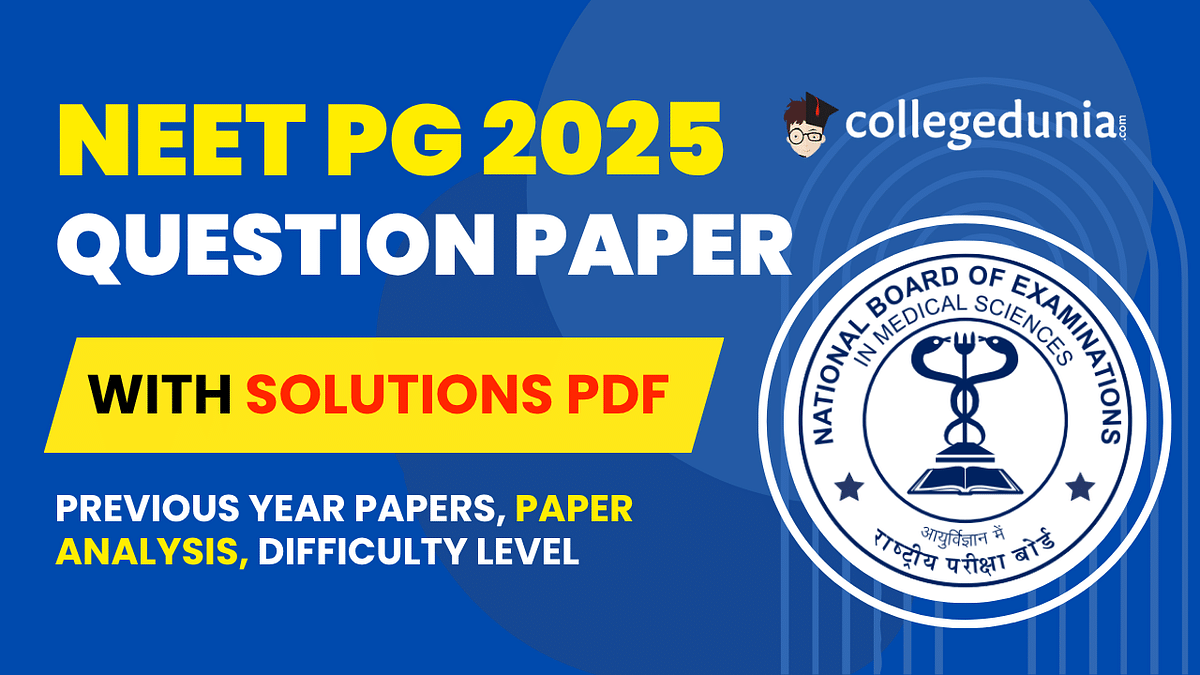NEET PG 2025 Question Paper PDF is available available for download here. NBEMS conducted NEET PG 2025 exam on August 3, 2025 from 9 AM to 12.30 PM. NEET PG 2025 was conducted in online CBT mode for a duration of 3 hours 30 minutes. NEET PG 2025 question paper comprises 200 questions carrying a total weightage of 800 marks.

NEET PG 2025 Question Paper with Solutions PDF
| NEET PG 2025 Question Paper with Solutions PDF | Download PDF | Check Solutions |
Question 1:
Which of the following cranial nerves is responsible for the motor innervation of the muscles of mastication?
The primary source of energy for Earth’s climate system is:
Which enzyme is deficient in Gaucher’s disease?
The most common site of metastasis for breast cancer is:
Which of the following is a loop diuretic?
The normal pH of arterial blood is:
Which of the following is a characteristic feature of Parkinson’s disease?
The primary auditory cortex is located in which lobe of the brain?
Which vitamin deficiency is associated with Wernicke’s encephalopathy?
The causative organism of syphilis is:
Which of the following drugs is a first-line treatment for tuberculosis?
The most common type of anemia worldwide is:
Which structure forms the roof of the third ventricle?
The hallmark feature of diabetic ketoacidosis is:
Which of the following is a beta-lactam antibiotic?
The most common site of ectopic pregnancy is:
Which hormone is responsible for milk ejection during breastfeeding?
The Reed-Sternberg cell is a hallmark of which condition?
Which of the following is a feature of Cushing’s syndrome?
The causative agent of malaria is:
Which of the following is a side effect of long-term corticosteroid use?
The most common cause of bacterial meningitis in adults is:
Which of the following is a feature of rheumatoid arthritis?
The anticoagulant effect of heparin is monitored using:
Which of the following is a complication of untreated hypertension?
The most common type of skin cancer is:
Which of the following is a hallmark of acute pancreatitis?
The drug of choice for absence seizures is:
Difficulty Level of NEET PG Exam 2025
| Aspect | NEET PG 2024 Exam | Expected NEET PG 2025 Exam |
| Overall Difficulty Level | Moderate to High | Moderate to High (Expected) |
| Clinical Questions | More clinical-based questions | Likely to include more clinical-based questions |
| Theory-based Questions | Balanced mix of theory and clinical | Expected to have a similar mix, but with slightly more clinical application |
| Image-based Questions | Moderate number of image-based questions | Increased image-based questions expected, especially from anatomy and pathology |
| MCQ Distribution | Balanced across subjects | Similar distribution, but may lean towards clinical subjects |
| Subject-wise Difficulty | - Anatomy: Moderate- Physiology: Moderate- Biochemistry: Easy to Moderate- Pathology: Moderate to High- Pharmacology: Moderate- Microbiology: Moderate | - Anatomy: Likely to remain Moderate- Physiology: Moderate to High- Biochemistry: Moderate- Pathology: High (expected)- Pharmacology: Moderate- Microbiology: Moderate |
| Time Management | Manageable with 3.5 hours | Same, but may require faster response for more image-based questions |
| Topics with Higher Weightage | Pathology, Pharmacology, Physiology | Expected similar weightage, with a slight increase in clinical topics |
| Overall Experience | Steady, manageable, with mixed difficulty | Expected to be similar, with a slight increase in clinical and image-based questions |







Comments